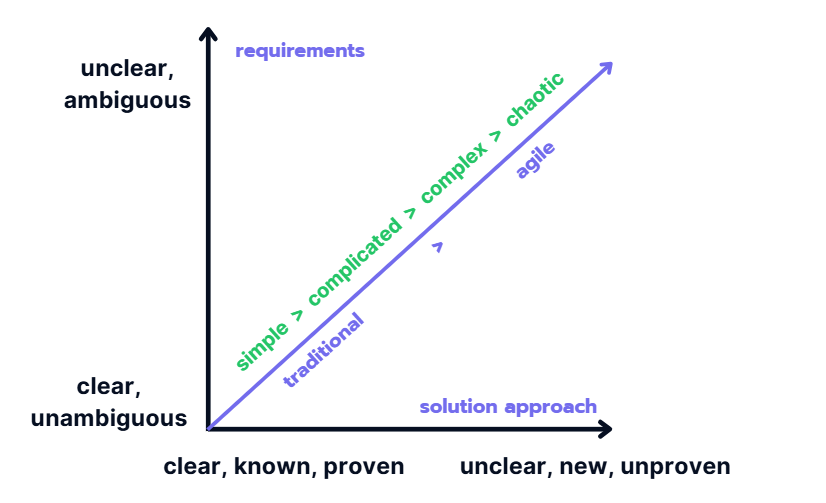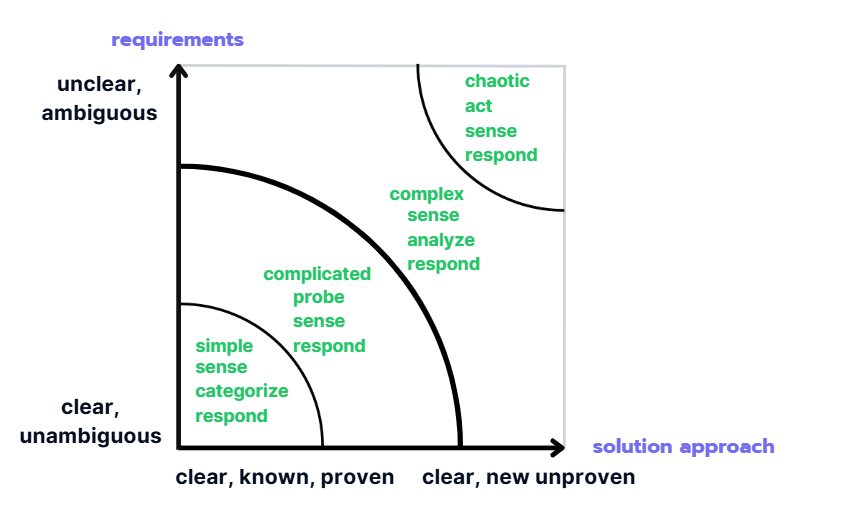The Stacey Matrix is an important tool for navigating complexity in project management, developed by Ralph Douglas Stacey in the 1990s.
In this article, we’ll break down how the matrix works, explore different project types, and discuss its relevance in consulting and case interviews. Plus, we’ll dive into its strengths and limitations in project management. Let’s get started!
What Is the Stacey Matrix?
The Stacey Matrix is a tool for representing and managing complexity in projects. It helps teams navigate uncertainty and align on the most suitable approach for project execution. It consists of two axes: Requirements (y-axis) and Approach (x-axis). Requirements represent “what” needs to be developed, while the Approach represents the 'how'. It is commonly used in software development and IT consulting to determine the complexity of a project or task. 🚀

Within the axes, there are four areas:
- Simple
- Complicated
- Complex
- Chaotic
The character of a project is defined along its bisecting line. Closer proximity to the axes' intersection denotes simplicity, with clear goals and established approaches. Moving away leads to increasingly complex areas, culminating in ambiguity where goals and approaches are entirely unknown. In the IT sector, this scenario is commonly termed "agile," relying on agile frameworks for problem-solving.
The following diagram represents the Stacey Matrix, with the Y-axis indicating the clarity of requirements (from unclear to clear) and the X-axis representing the solution approach (from clear and proven to new and unproven). Projects are categorized into four types: simple, complicated, complex, and chaotic, based on the clarity of requirements and the approach to solutions.

Four Examples of Classification Into Individual Project Types
The structure of the Stacey Matrix becomes clearer when we illustrate the four areas of the individual project types using examples.
➡️ Simple Projects
A simple project is characterized by clearly defined requirements and a known approach. For example, using a familiar technology to fulfill well-established requirements qualifies as a "simple" or "trivial" project, where the solution is straightforward. In such cases, the traditional waterfall model is suitable for project management, as it involves working through predetermined steps without the need for extensive adaptation or iteration.
➡️ Complicated Projects
However, when either or both of these factors change, projects become more complex. For example, in IT, this might mean using a new technology that the team isn't fully proficient with, or implementing new requirements that haven't been addressed previously. In such cases, more time is needed for upfront planning and exploration, as the team is venturing into unfamiliar territory. Examples include adopting a new JavaScript library, entering a new market, or integrating a new invoicing system.
➡️ Chaotic Projects
It goes even further when both the solution approach (or technology) and the requirements are completely unknown - "chaotic". The question arises, how does one plan a project when neither the requirements nor the approaches to be used are partly unknown? The answer is simple: one can't. Chaos can't be planned.
This is also the reason why, especially in IT, agile frameworks like Scrum or Kanban are used in this case. When neither the requirements or the approaches are known, one must gradually approach the supposed goal.
The current most famous examples of Chaotic problems in consulting are the economic crisis, a pandemic like COVID-19, or wars.
➡️ Complex Projects
However, between the complicated and the chaotic area lies another area called "complex". In a complex system or project, the boundary conditions - requirements and approaches - can be set and left unchanged so that the system can self-organize within these boundaries.
A consulting example for this is the development of a new business model or the introduction of a new product.
The Problem Statement in the Case Interview
The Stacey Matrix is a tool for decision-making that helps identify problems in case interviews. It considers the chosen solution approach and the team's familiarity with methods to determine the implementation strategy and the type of case.
👉 Solve 200+ cases in our Case Library now!
By using the Stacey Matrix for the case at hand or the respective project, clarity is created for the upcoming tasks. By first determining the 'What' requirements on the Y-axis and then defining the 'How' on the X-axis, the solution path and implementation can be derived.
Advantages and Disadvantages of Using The Stacey Matrix in Consulting
The use of the Stacey Matrix in consulting primarily serves to visualize the problem at hand. This results in advantages and disadvantages of using it in a case interview, with the client or within projects:
Advantages:
- The Stacey Matrix is quickly drawn by hand on a flip chart or paper to explain the situation to stakeholders.
- All stakeholders can evaluate projects upfront, identifying potential frustrations early.
- It uncovers challenges and responsibilities early, influencing personnel decisions.
- The division into 'What' and 'How' clarifies argumentation and approach structuring.
Disadvantages:
- In practice, 'What' is typically decided by higher management, not 'How', making complete classification challenging.
- The Matrix doesn't suggest approaches to the problem. Participants with varying experience levels may assess projects differently.
- It's a model and doesn't consider real-world factors like project environment, resources, and time constraints.
- Depending on how it's used, the Stacey Matrix can be manipulated to fit one's agenda, potentially shaping the project to fit a predetermined approach rather than adjusting the approach to fit the project.
Conclusion on the Stacey Matrix
Especially in agile or digital transformation projects, the Stacey Matrix is a frequently used tool to determine the complexity of corporate structures, processes, and projects. Specifically in the area of decision-making in complex or chaotic situations, it can help to find a suitable project management approach as quickly as possible.
💡 Depending on experience, however, one should be careful that the actual purpose of the Matrix is not subordinated to one's own interests, for example, to select a specific, familiar solution approach (Waterfall, Lean, Agile).
Practice Cases with the Stacey Matrix
Why not apply the Stacey Matrix in realistic case studies! We've compiled three fitting cases for you. Don’t forget: The more you practice, the better you get! 💪



